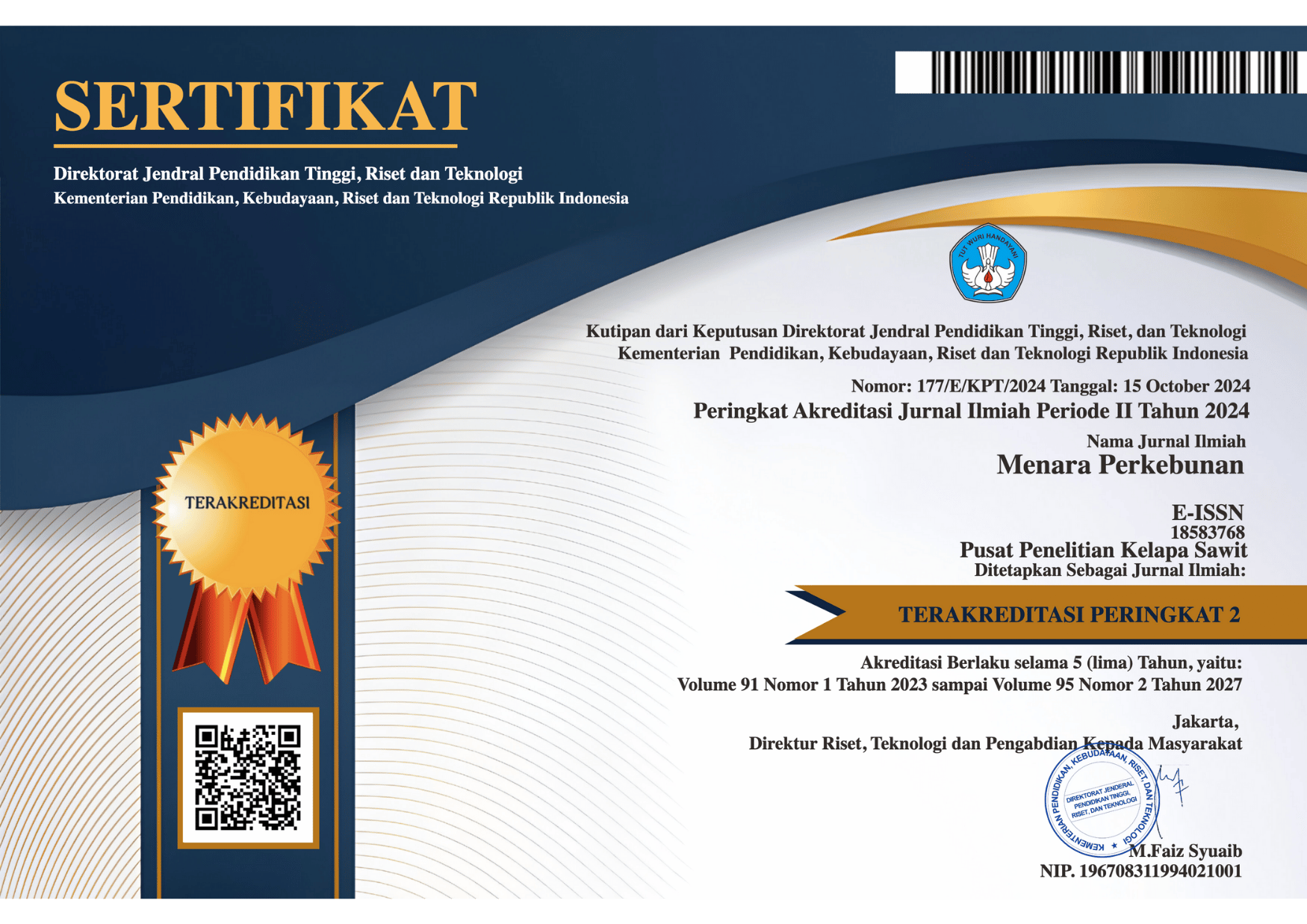Structure-based virtual screening of bioherbicide candidates for weeds in sugarcane plantation using in silico approaches
DOI:
https://doi.org/10.22302/iribb.jur.mp.v88i2.379Keywords:
diuron, molecular docking, photosynthesis inhibitionAbstract
Weeds in sugarcane have negatively affected the sugar yield rate. Several approaches have been carried out to overcome the weeds, including the usage of diuron as synthetic herbicide. However, the long-term usage of diuron is known to have a negative effect leads to the production of 3,4- Dichloroaniline responsible for soil leach and bioaccumulation. Therefore, this study aimed to find a potential natural herbicide. By mimicking the diuron's mode of action which inhibits the process of photosynthesis through blocking the Photosystem II protein D1 (psbA) of the weeds, fourteen compounds as potential candidate bioherbicides were virtually docked by PyRx v0.9.5 software to the specific site. Three important species of the weeds were chosen including Eleusine indica, Praxelis clematidea, and Momordica charantia. The binding affinity score was further calculated and ranked to screen the top six compounds as bioherbicide candidates. Interaction of each complex and the biological activity prediction were then performed by Discovery Studio software and PASS server, respectively. Aurachin P, Aurachin A, and Cyanobacterin were placed in the top ranked compounds with high binding affinity score around -6 to -9 kcal mol-1 toward the psbA. The amino acid interaction involved in the complex shows 50-90% similar to the control, psbA and diuron complex. Besides, the biological activity prediction of Aurachin P, Aurachin A, and Cyanobacterin exhibits the terms related to the inhibition of photosynthesis process via enzymatic pathway. Thus, the active compounds might have inhibition action in the photosynthesis process and control the weeds in sugarcane.
Downloads
References
Dallakyan S, Olson AJ (2015). Small-molecule library screening by docking with PyRx. Methods Mol Biol. 1263, 243-50. doi: 10.1007/978-1-4939-2269-7_19.
Dassault Systèmes BIOVIA, BIOVIA Visualizer, Release (2017). San Diego, Dassault Systèmes.
Dayan FE, Duke SO (2014). Natural compounds as next-generation herbicides. Plant Physiol. Nov;166(3), 1090-105. doi: 10.1104/pp.114.239061. Epub 2014 Apr 30.
Délye C, Jasieniuk M, Le Corre V (2013). Deciphering the evolution of herbicide resistance in weeds. Trends Genet. 29, 649–658. doi: 10.1016/j.tig.2013.06.001.
Eyal E, Gerzon S, Potapov V, Edelman M, Sobolev V (2005). The limit of accuracy of protein modeling: influence of crystal packing on protein structure. J Mol Biol. 351(2), 431-42.
Filimonov D.A., D.S. Druzhilovskiy, A.A. Lagunin, T.A. Gloriozova, A.V. Rudik, A.V. Dmitriev, P.V. Pogodin, V.V. Poroikov (2018). Computer-aided prediction of biological activity spectra for chemical compounds: opportunities and limitations. Biomed Chem: Res and Methods 1(1), 1-21.
Giacomazzi S, Cochet N (2004). Environmental impact of diuron transformation: a review. Chemosphere 56(11), 1021-32.
Gianessi LP (2005). Economic and herbicide use impacts of glyphosate‐resistant crops. Pest Manag. Sci. 61:241–245. doi: 10.1002/ps.1013.
Hall, T (2011). BioEdit: An important software for molecular biology. GERF Bulletin of Biosciences 2(1):60-61
Huovinen M, Loikkanen J, Naarala J, Vähäkangas K (2019). Toxicity of diuron in human cancer cells. Toxicol In Vitro 29(7):1577-86. doi: 10.1016/j.tiv.2015.06.013. Epub 2015 Jun 15.
Gao, J., Wang, H., Yuan, Q., & Feng, Y (2018). Structure and Function of the Photosystem Supercomplexes. Front plant sci 9, 357. https://doi.org/10.3389/fpls.2018.00357
J Yang, Y Zhang (2015). I-TASSER server: new development for protein structure and function predictions. Nucleic Acids Res 43: W174-W181
Kufareva Irina and Ruben Abagyan (2012). Methods of protein structure comparison. Methods Mol Biol. 857: 231–257. doi:10.1007/978-1-61779-588-6_10.
Morales Maria Aparecida Marin, Bruna de Campos Ventura-Camargo and Márcia Miyuki Hoshina (2013). Toxicity of Herbicides: Impact on Aquatic and Soil Biota and Human Health. Herbicides - Current Research and Case Studies in Use. USA, IntechOpen, DOI: 10.5772/55851.
Meng, X. Y., Zhang, H. X., Mezei, M., & Cui, M. (2011). Molecular docking: a powerful approach for structure-based drug discovery. Curr comput-aid drug 7(2), 146–157. https://doi.org/10.2174/157340911795677602
Peng S (2012). The biology and control of weeds in sugarcane. USA, Elsevier.
Pinzi, L., & Rastelli, G. (2019). Molecular Docking: Shifting Paradigms in Drug Discovery. Int J Mol Sci 20(18): 4331. https://doi.org/10.3390/ijms20184331
Salmaso, V., & Moro, S (2018). Bridging Molecular Docking to Molecular Dynamics in Exploring Ligand-Protein Recognition Process: An Overview. Front pharmacol 9: 923. doi:10.3389/fphar.2018.00923
Singh J., and Kumar R (2013). Management of weeds for sustainable sugarcane production in subtropical India. Indian J Sugarcane Technol., 28: 95-9.
Singh W. Dhiren, Ravindra Pal Singh, R. P. Malik, Rajiv Mehta (2011). Effect of planting density and weed management options on weed dry weight and cane yield of spaced transplanted sugarcane (Saccharum officinarum L.) after wheat harvest in sub-tropical India. Indian J Weed Sci. 43:97-100.
Velki, M., Lackmann, C., Barranco, A. et al. (2019). Pesticides diazinon and diuron increase glutathione levels and affect multixenobiotic resistance activity and biomarker responses in zebrafish (Danio rerio) embryos and larvae. Environ Sci Eur 31, 4, https://doi.org/10.1186/s12302-019-0186-0
Wakabayashi K, Böger P (2002). Target sites for herbicides: entering the 21st century. Pest Manag. Sci. 58:1149–1154. doi: 10.1002/ps.560.
Wessels, JSC and R. Van Der Veen (1956). Biochim et Biophys. Acta 19, 548.
Yao Hong-Yan and Hong-Wei Xue (2018). Phosphatidic acid plays key roles regulating plant development and stress responses FA. J. Integr. Plant Biol. 60: 851–863
Downloads
Submitted
Accepted
Published
How to Cite
Issue
Section
License
Authors retain copyright and grant the journal right of first publication with the work simultaneously licensed under a Creative Commons Attribution License that allows others to share the work with an acknowledgement of the work's authorship and initial publication in this journal.













